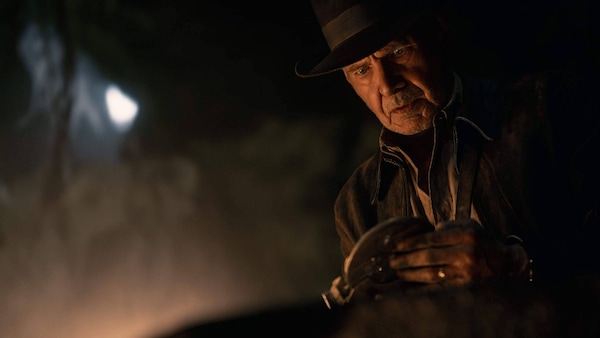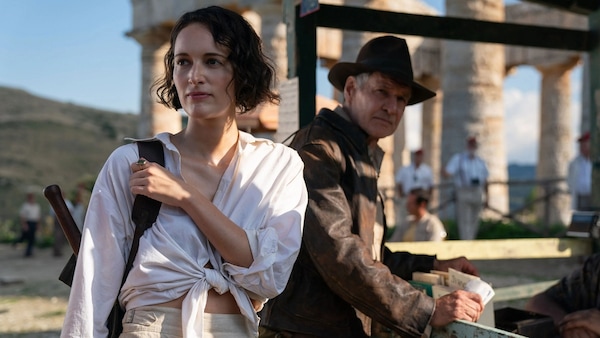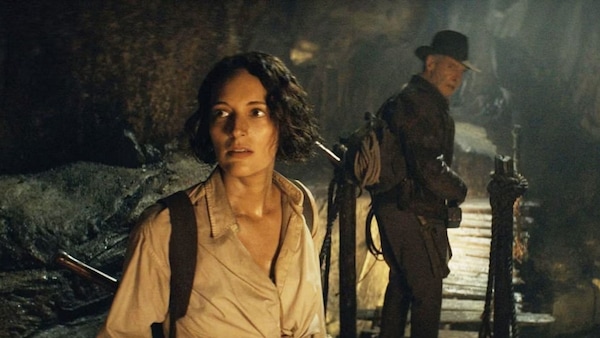Indiana Jones & The Dial Of Destiny: A Hero Gets His Last Hurrah
Harrison Ford gets one final but frail crack of the whip in Indiana Jones 5. There are riddles to be solved, Nazis to be bashed, and a mysterious artefact to be secured, writes Prahlad Srihari.

Last Updated: 06.03 PM, Jun 29, 2023
EVERY Indiana Jones movie is built around a MacGuffin: a coveted artefact which is at once the most and the least important object. Most important because the pursuit of it provides viewers with a guide rope; least important because it could be just about anything and nothing. Meaning the artefacts are catalyst and currency in the Indiana Jones universe. But what gives the objects meaning is the people after them. For whatever reason. For the bad guys, it is a Faustian shortcut to the usual Big Three: power, fortune, immortality. For Indy, each paves the way for his evolution from a professional looter acting out of self-interest to a swashbuckling archaeologist trying to do better.
Every MacGuffin came with its own design. The quest for the Ark of the Covenant in Raiders of the Lost Ark teaches Indy to put science aside and respect the intangible power of the Divine, while the Nazis pay for their disrespect with their lives. The quest for the Holy Grail in The Last Crusade coincides with Indy reconnecting with his father and learning to move on from the past. The quest for Sankara Stones (American for Shiva lingas) in the Temple of Doom lets Indy play white saviour to us Indian savages who enjoy our boa constrictors stuffed with live baby eels and chilled monkey brains served like coconut cocktails. The quest for the alien whatsit in the Kingdom of the Crystal Skull allows Indy to chance upon the only way to survive a nuclear explosion: hiding in a refrigerator.
Fifteen years later, Harrison Ford gets one final but frail crack of the whip in Indiana Jones and the Dial of Destiny. Per the norm, there are riddles to be solved, Nazis to be bashed, and a mysterious artefact to be secured. The artefact, this time around, is the Antikythera: a device, the movie insists, was invented by Ancient Greek mathematician Archimedes and rumoured to be capable of time travel. Not by coincidence, we have a hero who built his legacy searching for artefacts lost to time — and who is close to becoming an artefact himself. A man who broke into burial chambers aplenty now has one foot in his own grave.

When you get right down to it, what is time if not the dial of destiny? What is mortality if not the clock ticking down? In defiance, Indy turns back the clock for one last adventure. Director James Mangold gives Indy what he gave Wolverine in Logan: a last hurrah. If Logan took the mythic-heroic journey of the gruff mutant to its logical and emotional end-point, The Dial of Destiny struggles to do likewise for Indy. Mangold crafts a touching tribute to Ford’s hero, but not a whip-cracking adventure worthy of him.
The adventure begins at the end of WWII with Nazis running away with half of the world’s antiquities on a train bolting through the Alps. On board are a younger Indy (Ford de-aged) and trusty colleague Basil Shaw (Toby Jones) in search of the Lance of Longinus: the weapon said to have pierced the dying Jesus as he hung from the cross. Also on board is one half of the aforementioned Antikythera, which Nazi physicist Jürgen Voller (Mads Mikkelsen) believes can change the outcome of the war and revamp history. Mikkelsen may be inheriting more or less the same plot function performed by Paul Freeman’s René Belloq and Julian Glover’s Walter Donovan in previous entries, but he brings an icy severity that has made him a Hollywood franchise favourite for playing bad guys.
In a story about a device that allows people to travel back in time, it is the devices of the future that end up sabotaging the movie. The advances of CGI don’t smoothen the action amidst the blitzkrieg plotting, but make it creakier, much more than the 80-year-old Ford. Set-pieces are staged with stiff deliberation and edited with dynamic cuts — a sickness that has taken hold of every summer blockbuster these days. Their different-but-sameness can best be described by what a character in the movie says about a card trick: “I offer the feeling of choice, but I ultimately make you pick the one I want.” Ford riding through New York’s subway tunnels on horseback, driving an auto at full tilt through the busy streets of Tangier, and punching a whole bunch of Nazis — just about everything is rendered fuzzy in the digital noise. The de-aging has the same effect as Indy finding the fountain of youth and harnessing its powers. Wrinkles all smoothed out, the digitised Ford threatens to overwrite our memory of the younger Indy. No matter how precise a reconstruction you may think it is, there is something off-putting about an exercise that reconjures youth by image but not in body and flesh, like an unearthly invocation of an old ghost.

Twenty-five years after the train escapade, flash-forward to 1969, Indy has turned into the crabby old man, complaining to the young neighbours living next door not to blast the Beatles and Bowie early in the morning. He lives alone in a Manhattan apartment, he’s divorced, he has lost his son in the Vietnam War, and he is about to retire as a professor of archaeology. Ford’s charisma may not be quite as effortless as it once was, but he manages to locate a haunted sadness in his character. Indy is a man teaching about the past in a world where everyone is more excited about the future. The US has landed a man on the moon — with the help of Nazi engineers and scientists, one of whom is Voller.
Though Voller may be aiding the American cause for technological advancement, his Third Reich ambitions haven’t waned. The Antikythera remains his object of obsession. So it does for Shaw’s daughter and Indy’s goddaughter Helena (Phoebe Waller-Bridge). With Nazi henchmen hot on her heels, she comes to Manhattan seeking Indy’s help to track down the device — setting the two on course for an adventure spanning Morocco, Italy and Greece. Waller-Bridge as Helena brings a bit of mischief and energy to the paycheque party, complemented by a Short Round-like, street-thieving, younger sidekick of her own in Ethann Isidore’s Teddy. But it is hard to imagine either taking over the reins from Ford if there were to be a franchise extension.

All this is not to say Mangold’s efforts are entirely incompetent. Taking over from Steven Spielberg is no doubt an intimidating challenge for any director. Mangold cannot match the old master’s kinetic camerawork and pictorial eye. Any sense of adventure is diluted by the feeling of a fan-compliant checklist being ticked off. Few familiar faces (like John Rhys-Davies’ Egyptian excavator Sallah) make a return. Creepy crawlies make us squirm. John Williams’ orchestration calibrates the action to perfection and rekindles nostalgia. This being Indy’s swan song puts a second coat of nostalgia on an already old hat. But The Dial of Destiny is nowhere close to a fitting valediction for the character, only a functional one. When Indy hangs his hat, we get the feeling of a life well-lived, not of a corpus well-completed. For those jonesing for one final fix, it would be best to turn back the dial of destiny and relive the franchise’s past glories. Never mind what the movie has to say about leaving the past behind and looking to the future.
